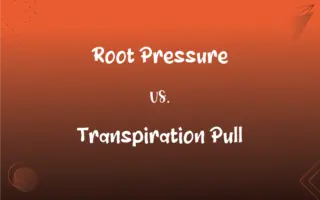Sitar vs. Veena: What's the Difference?
Edited by Aimie Carlson || By Harlon Moss || Published on February 4, 2024
Sitar is a plucked string instrument from North India, known for its long neck and distinct sound, while Veena is a South Indian string instrument, revered in classical music for its deep, resonant tones.

Key Differences
The sitar, originating from North India, is integral to Hindustani classical music. The veena, with its roots in South India, holds a significant place in Carnatic music tradition.
A sitar typically features a long, hollow neck and a gourd body, with 18-20 strings including both melody and drone strings. The veena is characterized by a large resonating body, a long fingerboard with frets, and usually has four main strings and three drone strings.
The sitar is noted for its complex playing technique involving meends (glides) and gamaks (ornamentations), ideal for Hindustani ragas. The veena, with its emphasis on gamakas, is central to the melodic and rhythmic aspects of Carnatic music.
Sitar construction involves tuning pegs for its many strings and a distinctive bridge that creates its unique buzzing sound. The veena's construction allows for sustained notes and intricate finger techniques, with tuning done using pegs at the end of its neck.
The sitar gained international fame through artists like Ravi Shankar and its influence in world music. The veena, while less internationally known, is revered in Indian classical music for its rich tonal quality and cultural heritage.
ADVERTISEMENT
Comparison Chart
Origin
North India
South India
Strings
18-20, including melody and drone strings
4 main strings, 3 drone strings
Musical Tradition
Hindustani classical music
Carnatic classical music
Playing Technique
Meends, gamaks
Emphasis on gamakas and sustained notes
Global Recognition
Widely recognized, especially in the West
Lesser-known globally, deeply revered in Indian culture
ADVERTISEMENT
Sitar and Veena Definitions
Sitar
Classical Music.
Classical sitar performances showcase intricate ragas.
Veena
Stringed Instrument.
The veena produces deep, resonant tones unique to its design.
Sitar
String Instrument.
The sitar's captivating melodies are a hallmark of North Indian music.
Veena
Cultural Symbol.
In Indian mythology, the veena is often associated with the goddess Saraswati.
Sitar
Cultural Icon.
The sitar became globally famous through Ravi Shankar's concerts.
Veena
Classical Instrument.
The veena is central to South Indian Carnatic music.
Sitar
Physical Design.
A sitar is easily recognized by its long neck and gourd body.
Veena
Construction.
A veena's large resonating body and fretted fingerboard are distinctive.
Sitar
Playing Technique.
Mastering the sitar involves learning complex meends and gamaks.
Veena
Musical Technique.
Playing the veena requires dexterity for intricate finger movements.
Sitar
A stringed instrument of India having a seasoned gourd for a body and a hollow wooden neck with movable raised frets. Stretched over the frets are usually 6 or 7 metal strings on which the melody is played with a pick, and stretched under the frets are 11 or more sympathetic resonating strings.
Veena
Variant of vina.
Sitar
(musical instruments) A Hindustani/Indian classical stringed instrument, typically having a gourd as its resonating chamber.
Veena
(musical instrument) A plucked stringed instrument with five or seven steel strings stretched on a long fretted finger-board over two gourds, used mostly in Carnatic Indian classical music.
Sitar
A stringed instrument of India; has a long neck and movable frets; has 6 or 7 metal strings for playing and usually 13 resonating strings
FAQs
What is a veena?
A string instrument central to South Indian classical music.
What is a sitar?
A plucked string instrument prominent in North Indian music.
How is the veena different in terms of strings?
It usually has four main strings and three drone strings.
What music tradition is the sitar associated with?
Hindustani classical music.
Where did the sitar originate?
In North India, evolving from Persian influences.
Is the veena adaptable to contemporary music?
It's primarily used in traditional settings, but some artists have explored contemporary adaptations.
How many strings does a sitar have?
Typically 18-20, including melody and drone strings.
Is the veena well-known internationally?
Less so than the sitar, but it's highly respected in Indian music circles.
What distinguishes the veena's sound?
Its deep, resonant tones and emphasis on sustained notes.
And the veena?
It's associated with Carnatic classical music.
What's the historical significance of the veena?
It's one of the oldest Indian classical instruments with mythological importance.
What's unique about the sitar's sound?
Its distinctive buzzing sound and capacity for glides and ornamentations.
How difficult is it to learn the sitar?
It requires dedication and practice, especially to master its intricate techniques.
And for the veena?
Usually jackwood is used.
Are there famous schools for learning the sitar?
Yes, several schools in India and abroad specialize in sitar training.
Who popularized the sitar globally?
Ravi Shankar, among others.
What kind of wood is used for making a sitar?
Typically teak or tun wood.
Can the sitar be used in modern music?
Yes, it's been incorporated into various genres, including fusion and world music.
What about learning the veena?
Similar to the sitar, it requires practice, with a focus on finger dexterity.
What about institutions for the veena?
Many Carnatic music schools in India offer specialized veena training.
About Author
Written by
Harlon MossHarlon is a seasoned quality moderator and accomplished content writer for Difference Wiki. An alumnus of the prestigious University of California, he earned his degree in Computer Science. Leveraging his academic background, Harlon brings a meticulous and informed perspective to his work, ensuring content accuracy and excellence.
Edited by
Aimie CarlsonAimie Carlson, holding a master's degree in English literature, is a fervent English language enthusiast. She lends her writing talents to Difference Wiki, a prominent website that specializes in comparisons, offering readers insightful analyses that both captivate and inform.







































































